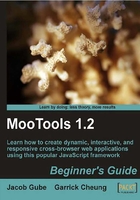
What this book covers
Chapter 1, MooTools and Me shows how to download and install Mootools. It demonstrates how to troubleshoot the most common installation problems. Writing a simple MooTools code block to test that the installation has worked is also explained.
Chapter 2, Writing JavaScript with MooTools demonstrates the difference between normal JavaScript against MooTools code. It explains how MooTools code can be far simpler and more efficient than ordinary JavaScript to achieve the same task.
Chapter 3, Selecting DOM Elements gives an overview of the Document Object Model tree and an in-depth discussion of the $() function in the Element class. It showcases basic DOM relationships such as parents, children, and siblings. It also demonstrates how to select page links and then give them a certain color or style
Chapter 4, The Core's Useful Utility Functions introduces native JavaScript variable definitions. It goes through each function and demonstrates how it works.
Chapter 5, Working with Events explains different browser events such as mouse click, mouse hover, mouse moving and key press. It demonstrates how to build a super-charged web form in MooTools. Events are covered showing how to add event listeners to web page elements.
Chapter 6, Bringing Web Pages to Life Using Animation introduces the different animation options available in MooTools. It demonstrates how to create a featured area slider. It demonstrates the MooTools Fx class and its useful methods for working with MooTools effects.
Chapter 7, Going 2.0 with Ajax shows the basics of Ajax. It demonstrates how MooTools makes working with Ajax easy. It will explain how XML files can be used to simulate a relational database.
Chapter 8, Beefing up MooTools Using the MooTools More Plugins demonstrates how to install and use the plug in system. It will explain how the Accordion area can be used to display content in an engaging and compact manner using the Fx Accordian plugin. It will also cover creating user-friendly forms using the OverText plugin.
Chapter 9, Creating Your Own Plugin will show the benefits of creating your own plugin such as reusability and customization. It will explain the guidelines and standards that should be adhered to for creating a plugin. It will also demonstrate how to build a simple plugin.